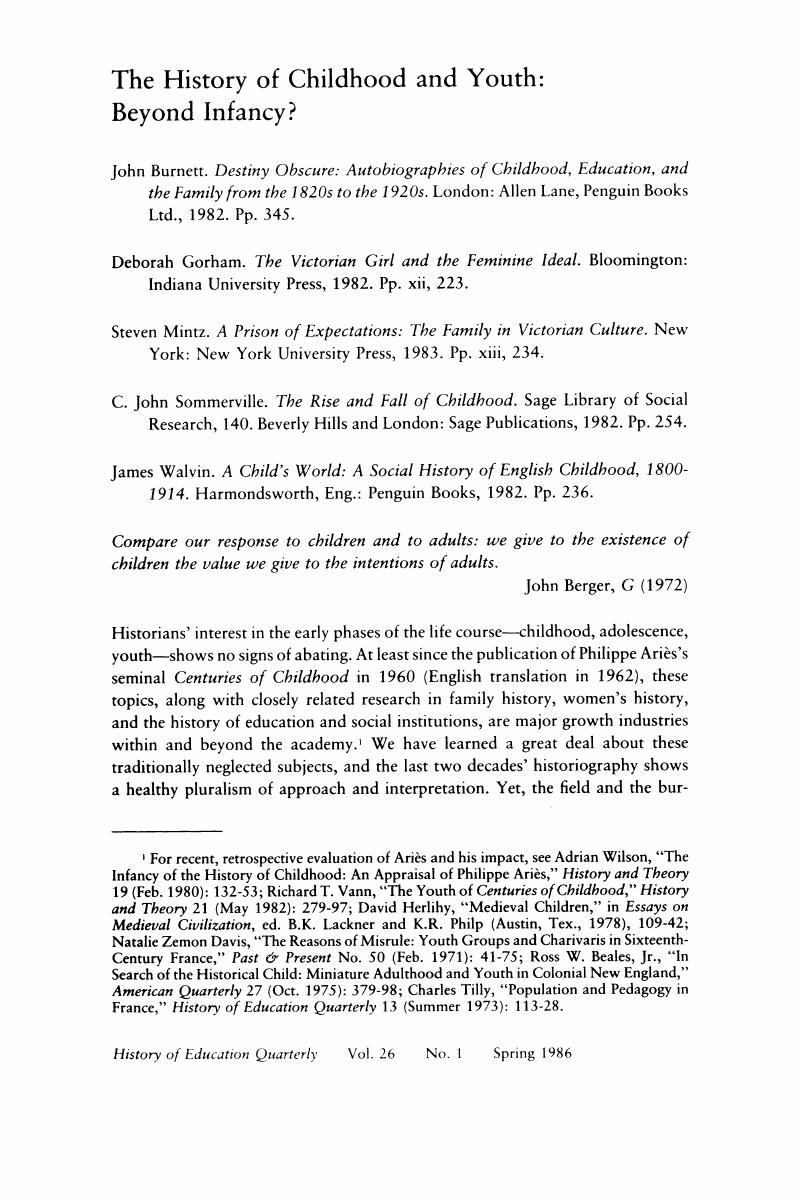Article contents
The History of Childhood and Youth: Beyond Infancy?
Published online by Cambridge University Press: 24 February 2017
Abstract

- Type
- Essay Reviews
- Information
- Copyright
- Copyright © 1986 by the History of Education Society
References
1 For recent, retrospective evaluation of Aries and his impact, see Wilson, Adrian, “The Infancy of the History of Childhood: An Appraisal of Philippe Aries,” History and Theory 19 (Feb. 1980): 132–53; Vann, Richard T., “The Youth of Centuries of Childhood” History and Theory 21 (May 1982): 279–97; Herlihy, David, “Medieval Children,” in Essays on Medieval Civilization, ed. Lackner, B.K. and Philp, K.R. (Austin, Tex., 1978), 109–42; Davis, Natalie Zemon, “The Reasons of Misrule: Youth Groups and Charivaris in Sixteenth-Century France,” Past & Present No. 50 (Feb. 1971): 41–75; Beales, Ross W. Jr., “In Search of the Historical Child: Miniature Adulthood and Youth in Colonial New England,” American Quarterly 27 (Oct. 1975): 379–98; Tilly, Charles, “Population and Pedagogy in France,” History of Education Quarterly 13 (Summer 1973): 113–28.CrossRefGoogle Scholar
2 See Hendrick, Harry, “The History of Childhood and Youth,” Social History 9 (Jan. 1984): 87–96; Gillis, John, “Youth in History: Progress and Prospects,” Journal of Social History 7 (Winter 1974): 201–7; Jarausch, Konrad H., “Restoring Youth to Its Own History,” History of Education Quarterly 15 (Winter 1975): 445–56; Kern, Steven, “The History of Childhood,” Journal of the History of the Behavioral Sciences 9 (Oct. 1973): 406–12; Calhoun, Daniel, “On the Psychohistory of Childhood,” History of Education Quarterly 14 (Fall 1974): 371–77; Ray Hiner, N., “The Child in American Historiography,” Psychohistory Review 7 (Summer 1978): 13–23.Google Scholar
3 See DeMause, Lloyd, ed., The History of Childhood (New York, 1974); Demos, John, The Little Commonwealth: Family Life in Plymouth Colony (New York, 1970); Greven, Philip J., The Protestant Temperament: Patterns of Child-Rearing, Religious Experience, and the Self in Early America (New York, 1977).Google Scholar
4 Kett, Joseph F., Rites of Passage: Adolescence in America, 1790 to the Present (New York, 1977); Gillis, John R., Youth and History: Tradition and Change in European Age Relations, 1770-Present (New York, 1974; expanded student edition, 1981).Google Scholar
5 Elder, Glen H. Jr., “Adolescence in Historical Perspective,” in Handbook of Adolescent Psychology, ed. Adelson, Joseph (New York, 1980), 3–46; Hareven, Tamara K., ed., Transitions: The Family and the Life Course in Historical Perspective (New York, 1978).Google Scholar
6 See Katz, Michael B., The People of Hamilton, Canada West: Family and Class in a Mid-Nineteenth-Century City (Cambridge, Mass., 1975); Katz, Michael B., Doucet, Michael J., and Stern, Mark J., The Social Organization of Early Industrial Capitalism (Cambridge, Mass., 1982); Ryan, Mary P., Cradle of the Middle Class: The Family in Oneida County, New York, 1790–1865 (New York, 1981).Google Scholar
7 See Norton Grubb, W. and Lazerson, Marvin, Broken Promises: How Americans Fail Their Children (New York, 1982), among the literature.Google Scholar
8 See Katz, , The People; Katz, , Doucet, , and Stern, , Social Organization; Gillis, , Youth and History; Kett, , Rites of Passage; and Ryan, , Cradle.Google Scholar
9 See John Sommerville, C., The Rise and Fall of Childhood, for one example.Google Scholar
10 Csikszentmihalyi, Milhaly and Larsen, Reed, Being Adolescent: Conflict and Growth in the Teenage Years (New York, 1984), 11–12.Google Scholar
11 See Yacovone, Donald, “Home as Found: Transformation and Transubstantiation of the Victorian Family,” Reviews in American History 11 (Dec. 1983): 543–46.Google Scholar
12 The types of sources exploited by Mintz, Steven and Gorham, Deborah merit critical comparison with those excerpted in Burnett, John, ed., Destiny Obscure: Autobiographies of Childhood, Education, and Family from the 1820s to the 1920s (London, 1982); those used in Vincent, David, Bread, Knowledge, and Freedom: A Study of Nineteenth-Century Working Class Autobiography (London, 1981); and with the oral histories collected and being studied by Paul Thompson's Essex University archive of “work, life, and family experience before 1918.” See below.Google Scholar
13 See for example Elder, Glen H. Jr., Children of the Great Depression: Social Change in Life Experience (Chicago, 1974), and his more recent essays.Google Scholar
14 See also Dyhouse, Carol, Girls Growing Up in Late Victorian and Edwardian England (London, 1981).Google Scholar
15 See Note 12, above; for work stemming from the Essex Project, see Thompson, Paul R., The Voice of the Past: Oral History (Oxford, Eng., 1978); Thompson, Paul R., The Edwardians (Bloomington, Ind., 1975); Thompson, Thea, Edwardian Childhoods (London, 1981); the journal Oral History, especially “Family History Issue,” 3, 2 (1975).Google Scholar
16 Compare this work with Sommerville's excellent “Bibliographic Note: Toward a History of Childhood and Youth,” Journal of Interdisciplinary History 3 (Autumn 1972): 439–47.Google Scholar
- 1
- Cited by


